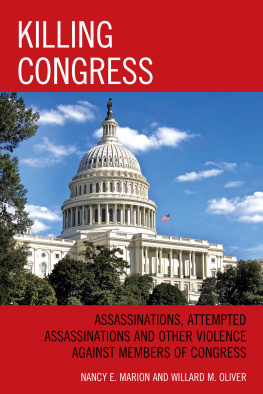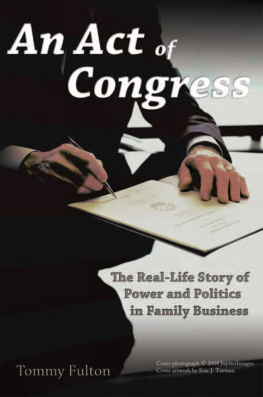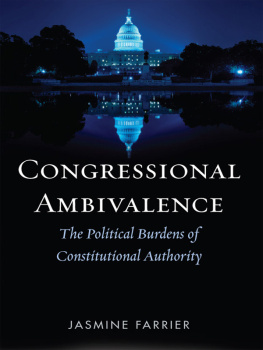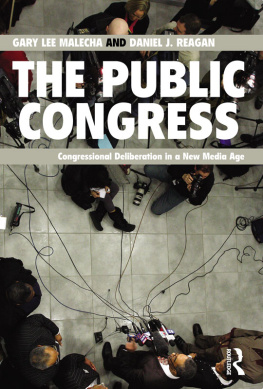Killing Congress
Killing Congress
Assassinations, Attempted Assassinations
and Other Violence against
Members of Congress
Nancy E. Marion and Willard M. Oliver
LEXINGTON BOOKS
Lanham Boulder New York London
Published by Lexington Books
An imprint of The Rowman & Littlefield Publishing Group, Inc.
4501 Forbes Boulevard, Suite 200, Lanham, Maryland 20706
www.rowman.com
16 Carlisle Street, London W1D 3BT, United Kingdom
Copyright 2014 by Lexington Books
All rights reserved. No part of this book may be reproduced in any form or by any electronic or mechanical means, including information storage and retrieval systems, without written permission from the publisher, except by a reviewer who may quote passages in a review.
British Library Cataloguing in Publication Information Available
Library of Congress Cataloging-in-Publication Data
Marion, Nancy E.
Killing Congress : assassinations, attempted assassinations and other violence against Members of Congress / by Nancy Marion and Willard Oliver.
pages cm
Includes bibliographical references and index.
ISBN 978-0-7391-8359-5 (cloth : alkaline paper) -- ISBN 978-0-7391-8360-1 (electronic)
1. Legislators--United States--Biography. 2. United States. Congress--Biography. 3. Assassination--United States--History. 4. Attempted assassination--United States--History. 5. Legislators--Assassination attempts--United States. 6. Legislators--Violence against--United States. 7. Political violence--United States--History. 8. United States--Politics and government. I. Oliver, Willard M. II. Title.
JK1030.M28 2014
364.152'4092273--dc23
2014019159
 TM The paper used in this publication meets the minimum requirements of American National Standard for Information Sciences Permanence of Paper for Printed Library Materials, ANSI/NISO Z39.48-1992.
TM The paper used in this publication meets the minimum requirements of American National Standard for Information Sciences Permanence of Paper for Printed Library Materials, ANSI/NISO Z39.48-1992.
Printed in the United States of America
Preface
Article I of the US Constitution establishes the US Congress, which is comprised of two bodies: a House of Representatives and a Senate. According to Article 1, Section 1, all legislative powers are vested in the United States Congress. This grants the members of Congress, not the president nor the Supreme Court, the power to make laws concerning many facets of American life. In Article 1, Section 8, many of these powers are specified, or enumerated, stating specifically what powers are granted to Congress. Here, Congress is given the power to make laws concerning, among other things, the payment of debt; to regulate commerce with foreign nations and among states; to coin (or print) money; provide for punishment of counterfeiting; declare war; maintain a navy, and to exercise exclusive legislation over the District of Columbia.
The Constitution also assigns the members of the House of Representatives additional responsibilities, such as initiating cases of impeachment of the president or members of the judiciary. In these cases, the House membership will investigate and possibly bring charges against an individual accused of improper behavior. The Senate then has the added responsibility to decide the validity of those charges. The Senate members also bear the added responsibilities of ratifying treaties and approving those nominated by the president to serve in certain government positions, such as the Attorney General of the United States or the head of the Federal Bureau of Investigation.
Other powers have been granted to Congress through amendments added to the Constitution in later years. After the Civil War, the Congress passed three amendments (the Thirteenth, Fourteenth and Fifteenth Amendments) through which Congress was granted the power to pass laws that enforce rights of African Americans (voting and equal protection). In addition, through the Sixteenth Amendment Congress was authorized the power to lay and collected taxes on income and through the Twenty-Sixth Amendment they were given the power to enforce by appropriate legislation the right of all citizens who are eighteen years of age or older to vote.
Moreover, Congress has implied powers through the Necessary and Proper Clause (also known as the Elastic Clause) that is found in Section 8 of the Constitution. This means that Congress can make all laws which shall be necessary and proper for carrying into execution the foregoing powers, and all other powers vested by this Constitution in the government of the United States...
Under the Constitution, Senators were originally elected by state legislatures in order to ensure that Senators were not free agents, but beholden to the people of their state, by way of their state legislatures, in order to retain their positions. This was changed in 1913 by the Seventeenth Amendment to the Constitution. Currently, members of Congress (both the House and Senate) are elected through a direct election process to serve in either the House or Senate. The representation of the House is based on a states population and can change based on the results of a national census, which is taken every ten years. There are currently 435 members elected to the House, and once elected, they serve two year terms. The representation in the Senate is equalevery state has two representatives. The 100 members of the Senate serve six year terms in office.
As part of their role as legislators, members of Congress must sometimes debate very controversial laws and policies. They must sometimes take positions or make statements that are not popular or that, for some reason, anger others. The member may say something that annoys a voter, or, in some rare instances, even irritates another member of Congress. In some cases, the opposition may become so outraged by a members statement or position that they have become violent and attacked the individual. Although it has happened very infrequently, there have been acts of violence perpetrated on members of Congress because of their policy positions or statements. The violence has ranged from spitting and shoving, to punching, assaults, fights, and even death. So, while the president of the United States is often the focal point of the assassins wrath, members of Congress have not been excluded from such vituperative attacks.
The first Congress convened in 1789 and met for two years, until 1791. Since then, a new Congress has begun every other year. Every new Congress is given a sequential number. The 113th Congress began in January 2013, and will end in January 2015. The 114th Congress will then begin in January 2015 and meet for two years. During the almost 250 year history of Congress, seven members have been assassinated. These include Hinds (1868), Haughey (1869), Pinckney (1905), Long (1935), Kennedy (1968), Ryan (1978), and McDonald (1983). All but McDonald were shot; McDonald was the victim of an airplane downing. Although McDonalds death may not necessarily fit in the same category as the other assassinations, the reasons why the plane was shot down remain unknown even today. There are many who claim that the plane was targeted because McDonald was an outspoken critic of communism. Whether or not that is the case, McDonalds killing was placed in the assassinations section because of the unique circumstances surrounding his death. These assassinations are described in detail in the first part of the current book. Chapters 17 each provide a detailed description and analysis of one assassination: the people who were directly involved in the assassination, the events, and the aftermath.
Since Congress began, there have been two attempted assassinations. In one of these, all of the members of the US House were potentially targeted when, in 1954, four Puerto Rican Nationalists entered the Visitors Gallery of the House of Representatives and shot at the members while they debated a bill. While five members were shot and injured, no one was killed. More recently, in 2011, Gabrielle Giffords, from Arizona, was shot in the head as she spoke with constituents. Although gravely and permanently injured, she survived the attack. These two events are described in part II of this book. Chapter 8 details the attack on Congress by the Puerto Ricans, and chapter 9 is an analysis of the events surrounding the violence directed toward Representative Giffords.
Next page














 TM The paper used in this publication meets the minimum requirements of American National Standard for Information Sciences Permanence of Paper for Printed Library Materials, ANSI/NISO Z39.48-1992.
TM The paper used in this publication meets the minimum requirements of American National Standard for Information Sciences Permanence of Paper for Printed Library Materials, ANSI/NISO Z39.48-1992.